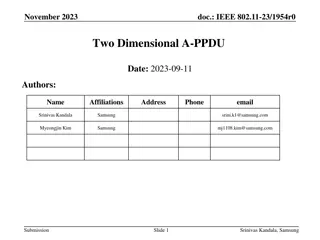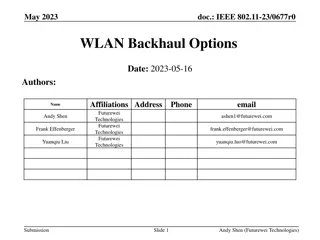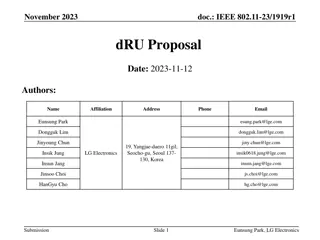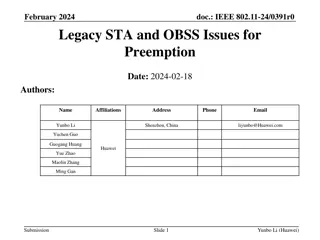Efficient dRU Tone Plan Design for UHR Communications
The document discusses the signaling techniques for Ultra-High Rate (UHR) communications using dRU (dense RU) for overcoming PSD limitations. It elaborates on the methods to construct a dRU tone plan and indicate dRUs within rRUs. The design involves defining different sizes of dRUs, combining tones
0 views • 28 slides
Principle and Methodology for dRU Tone Plan Design in IEEE 802.11-20
Introduction of Distributed Tone RU (dRU) as a potential UHR PHY feature to address PSD limitations for 6GHz LPI and enhance Rate vs. Range performance. Emphasis on dRU tone plan design criteria, methodologies, and performance simulations. Detailed examination of design principles, methods, consider
4 views • 23 slides
Two-Dimensional A-PPDU for Low Latency in UHR Networks
This document discusses the proposed two-dimensional (2D) A-PPDU as a solution for supporting low-latency applications in UHR networks. It delves into the details of 2D A-PPDU for downlink, focusing on the ability to insert PPDUs within a PPDU, aiming to reduce latency in UHR environments by enhanci
0 views • 17 slides
Enhanced Security Considerations in IEEE 802.11-23 for UHR
The document discusses enhanced security considerations for control frames and MAC headers in IEEE 802.11-23 addressing vulnerabilities and proposing encryption/decryption methods. It highlights the need for support for security protocols in control frames and the importance of protecting MAC header
0 views • 13 slides
WLAN Backhaul Options for Next-Generation Wi-Fi Networks
IEEE 802.11-23/0677r0 explores various backhaul options for WLAN, emphasizing Fiber to the Room (FTTR) technology based on Passive Optical Network (PON) for enhancing the performance of multi-AP coordinated next-gen Wi-Fi UHR. The document discusses wired and wireless backhaul connections, including
2 views • 15 slides
Protection of Extended TXOP Sharing in IEEE 802.11-23/1846r0
Reusing EHT's Triggered TXOP Sharing framework for extended TXOP sharing is discussed in this document, focusing on enabling sharing APs to distribute their obtained TXOP among other BSS(s). The document explores issues related to TXOP sharing for UHR STAs when a sharing AP allocates a portion of it
0 views • 12 slides
IEEE 802.11-23/1176r1 Multi-AP Simulations Overview
Detailed exploration of Joint Transmission (JT) simulation results for IEEE 802.11-23/1176r1, emphasizing real-world deployment scenarios in residential settings. The submission discusses topologies, considerations, and initial simulation outcomes, aiming to align with the UHR project goals and opti
0 views • 24 slides
Efficient Coordinated Spatial Reuse in IEEE 802.11-23
Coordinated Spatial Reuse (C-SR) is a Multi-AP transmission technique proposed for UHR networks that enhances efficiency by utilizing RSSI or pathloss feedback instead of complete CSI. This document introduces an efficient protocol for C-SR, focusing on a unified approach for better implementation.
0 views • 10 slides
Improving Latency Performance for Mobile Clients Using Non-Collocated AP MLD Framework
The UHR group aims to enhance latency performance for mobile clients by introducing a non-collocated AP MLD framework. This framework allows seamless transfer of client context between physical APs, improving roaming efficiency and supporting high numbers of links for non-AP MLDs. The proposed solut
3 views • 11 slides
IEEE 802.11-23/1980r1 Coordinated AP-assisted Medium Synchronization Recovery
This document from December 2023 discusses medium synchronization recovery leveraging multi-AP coordination for multi-link devices. It covers features such as Multi-link device (MLD), Multi-link operation (MLO), and Ultra High Reliability (UHR) capability defined in P802.11bn for improvements in rat
0 views • 8 slides
IEEE 802.11-23/1919r1dRU Proposal for Range Extension and RvR Enhancement
This proposal introduces dRU support for 11bn to overcome PSD limitations, enabling range extension and RvR enhancement. It reviews previous dRU contributions in UHR SG and details new proposals including distributed tones across channels, dRU tone plans in different MHz channels, and pilot designs
0 views • 22 slides
Enhancing Quality of Service in Ultra High Rate Wi-Fi Networks
This document explores the potential improvements in Quality of Service (QoS) for Ultra High Rate (UHR) Wi-Fi networks, focusing on the benefits of timing information sharing for traffic urgency assessment. It discusses areas such as increased reliability, lower latencies, improved manageability, an
0 views • 11 slides
Considerations on Multi-AP Operation in IEEE 802.11-23/1461r0
This document discusses considerations for multi-AP operation within IEEE 802.11 standards, focusing on selecting transmission schemes and scheduling for optimal performance. It explores the phases involved in multi-AP setup, coordination, selection, channel sounding, data sharing, and data transmis
0 views • 12 slides
Relay Communications for Ultra High Reliability in IEEE 802.11-22/1908r1
Investigating relay communications to enhance Rate-vs-Range (RvR) performance for Ultra High Reliability (UHR) in IEEE 802.11-22/1908r1. The content explores relay design objectives, goodput analysis, existing relay solutions like WiFi extenders, and the challenges in implementing relay technology t
3 views • 16 slides
UHR Seamless Roaming: Functionality and Security Architecture Proposal
Discussion on the technical requirements for UHR seamless roaming, focusing on the non-AP MLD state preservation and data exchange context between AP MLDs. Proposing a security architecture based on FT to achieve seamless roaming while cautioning against sharing PTK(SA) across multiple AP MLDs. Emph
0 views • 34 slides
Enhanced Replay Detection for Header Protection in IEEE 802.11-23/1960r1
Enhancing security in IEEE 802.11 is a key goal of UHR. This document discusses the need for improved replay detection mechanisms for header protection in the MAC layer. The proposal suggests incorporating a time component in the Packet Number (PN) to mitigate jam, record, and replay attacks. By uti
0 views • 11 slides
IEEE 802.11-23/1899r0 Relay Operation for 11bn - Presentation Summary
In this presentation, the IEEE 802.11-23/1899r0 document discusses relay operations to improve Rate-vs-Range (RvR) performance for UHR. Various potential solutions for implementing a relay protocol in UHR are explored, focusing on enhancing multi-hop channel access delay, end-to-end QoS, and simplif
0 views • 10 slides
Preemption Methods for Ultra High Reliability in Multi-AP C-TDMA
In this IEEE document, preemption methods are discussed for the coordinated time-division multiple-access (C-TDMA) scheme to enhance the Ultra High Reliability (UHR) capability in multi-AP operation. The focus is on reducing delays during large PPDU transmissions and improving coordination between s
0 views • 8 slides
IEEE 802.11-24/0161r1 OBSS R-TWT Announcement in Multi-BSS
The document discusses the coordination of R-TWT schedules in Multi-BSS to enhance operation and protection. It covers how APs announce OBSS R-TWT schedules to associated STAs, ensuring efficient transmission of latency-sensitive traffic. Methods for announcing OBSS R-TWT schedules to EHT STAs and U
0 views • 13 slides
Enhancing Medium Access Efficiency in IEEE 802.11 Networks
This presentation discusses the utilization of chirp signals for Ultra High Rate (UHR) STAs to access the medium efficiently, transmit reliably at reduced power levels, and handle interference challenges in IEEE 802.11 networks. It explores the concept of chirps, their differentiation from other pro
0 views • 20 slides
IEEE 802.11-24/0386r0 Lower MAC Relay Protocol Details
Detailed discussion on supporting the relay protocol in IEEE 802.11bn, covering relay addressing, end-to-end BA, relay TXOP protection, beacon forwarding, security processing, non-UHR STA support, sounding procedure, A-MPDU aggregation, de-aggregation, and more. The relay operation involves relay de
0 views • 16 slides
Legacy STA and OBSS Preemption Considerations in IEEE 802.11-24
Discussions in IEEE 802.11-24 address preemption issues related to UHR STAs within a single BSS, focusing on legacy STA impact and OBSS considerations. Proposed solutions aim to balance efficiency and latency by adjusting TXOP limits for different STA types.
0 views • 7 slides
Multi-AP for Reliable Wireless Transmission with Coherent and Non-coherent Technology
In this IEEE 802.11-23/2009r0 document, the concept of Multi-AP coordination is discussed to achieve Ultra High-reliability (UHR) goals. The use of both Coherent Joint Transmission (JT) and Non-coherent transmission technologies is explored for improved reliability and performance in wireless commun
0 views • 16 slides
Discussion on IEEE 802.11-23/1865r0: SST and A-PPDU
The document discusses the current lack of support for SST on S160 in 11be, highlighting that 11be AP and STA do not support A-PPDU. It explores potential combinations for A-PPDU involving UHR and non-UHR HE and EHT STAs, addressing bandwidth enhancements and benefits of various scenarios. The analy
0 views • 14 slides
IEEE 802.11-23 UHR PAR and CSD Comments Review
Reviewing comments and responses on IEEE 802.11-23/1166r2 UHR PAR and CSD focusing on enhancing Ultra High Reliability in Wireless Local Area Networks (WLAN) with clarifications and modifications for project scope and objectives.
0 views • 21 slides
Optimal SVD Based TXBF for Next-Gen WiFi Development
This November 2022 document focuses on the application of Optimal Singular Value Decomposition (SVD) in Transmit Beamforming (TXBF) for the next generation of WiFi standards. It discusses the background, objectives of UHR/SG, advantages of Optimal SVD-based TXBF, simulation results, and potential ch
0 views • 14 slides
Overlapped Indication for Event-Based Low Latency Traffic Support in IEEE 802.11
The document discusses the importance of reducing latency in Ultra High Rate (UHR) PAR and Event Based Low Latency (LL) traffic support in IEEE 802.11 networks. It introduces the concept of preemption to enhance LL traffic handling and proposes an overlapped LL indication frame to address challenges
0 views • 13 slides
Addressing Issues in Secondary Channel Access for IEEE 802.11-24 Networks
This submission for IEEE 802.11-24 discusses the potential issues and solutions related to secondary channel access (SCA) in UHR/11bn networks. The focus is on coordinating access points (APs) and stations (STAs) to optimize channel utilization without causing interference. The challenges include de
0 views • 12 slides
Integrating WUR into IEEE 802.11bn for Enhanced Network Efficiency
IEEE 802.11-24/0892r0 proposes integrating Wake-Up Radio (WUR) technology into 11bn networks to improve reliability, support low latency traffic, increase peak throughput, and enhance power-saving capabilities. The WUR acts as a companion radio to the main connectivity radio, enabling power-saving w
0 views • 10 slides
Preamble and PE Transmission in PPDU Using DRU
The document discusses the transmission of Preamble and Physical End with the DRU technology in PPDU for IEEE 802.11 networks. It covers various aspects such as legacy preamble, UHR-STF, UHR-LTF, PE fields, and SIG transmission. The focus is on achieving compatibility and performance efficiency in D
0 views • 13 slides
IEEE 802.11-23/1953r0 Two-Dimensional Resource Allocation (UL OFDMA)
Introducing a novel approach for uplink transmissions in UHR to achieve low-latency communication. The document discusses UL OFDMA in detail, emphasizing the use of a two-dimensional resource unit. Key topics covered include UL MU operation, UL OFDMA-based random access, and allocation of RUs for ra
0 views • 16 slides
Re-thinking Latency Improvement in WLAN Connectivity
This document delves into the latency issues in WLAN transmission, focusing on channel occupancy and access problems that contribute to delays. It discusses the objectives of the UHR Study Group in enhancing WLAN reliability, reducing latencies, managing throughput, and minimizing power consumption.
0 views • 9 slides































